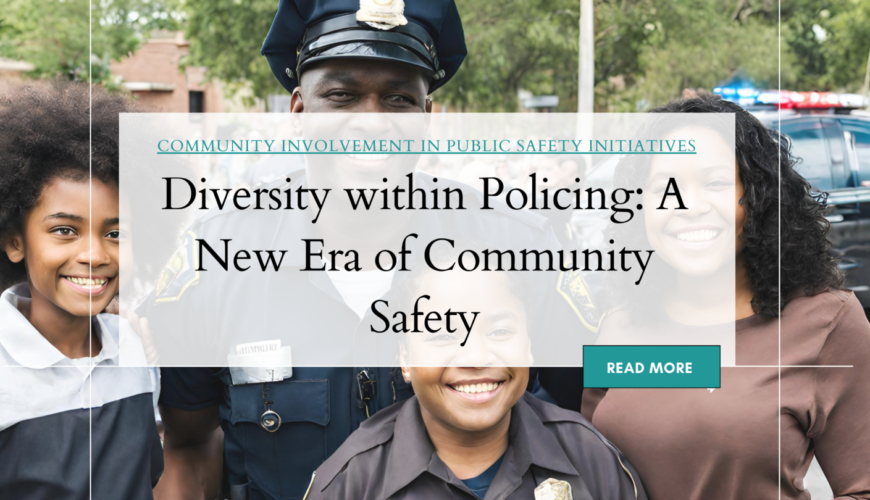Ever stopped to ponder about the faces in blue that patrol your neighborhood? Think they mirror the kaleidoscope of cultures and backgrounds we see every day?
You bet, it’s a hard question. But let’s take this journey together.
Being a Police Officer is more than just maintaining law and order. It’s about understanding people – their histories, experiences, fears, hopes… The magic happens when those wearing badges reflect the communities they serve. That’s diversity within policing for you!
In this deep dive into public safety and law enforcement strategies like New Jersey’s Newark Community Street Team (NCST), we’ll unpack how different voices bring fresh perspectives on community protection.
We’ll look at how treating violence as a health issue or helping victims can prevent further chaos. We will also touch upon how ex-cons turn credible messengers in reducing violence – yes! you heard it right!
Table Of Contents:
- The Newark Community Street Team: A Complementary Strategy to Policing
- The Impact of NCST on Homicide Rates in Newark
- Treating Violence as a Public Health Issue
- Victim Advocacy and Its Role in Preventing Retaliatory Violence
- Community Involvement in Public Safety Initiatives
- Recognition and Support for Community-Based Public Safety Initiatives
- FAQs in Relation to Diversity Within Policing
- Conclusion
The Newark Community Street Team: A Complementary Strategy to Policing
Although traditional law enforcement and police officers are essential for keeping order, there are other components of public safety that go beyond just policing. The Newark Community Street Team (NCST) is shaking up the norm by offering an alternative approach.
This groundbreaking initiative aims at violence prevention and community healing from within the neighborhoods themselves. By leveraging local knowledge and relationships, NCST has made significant strides towards safer streets.
The Three-Pronged Approach of NCST
In its mission to improve public safety, NCST uses a three-pronged strategy that takes into account various aspects of crime prevention. First off is the high-risk intervention team – a group primarily composed of former gang members who use their unique experiences to reach out and help those most likely involved in violent incidents.
Stats show this approach works, with homicide rates dropping significantly since its inception.[5]
The second prong involves assertive outreach work which targets individuals prone to criminal activities before they spiral down further.[6] It focuses on providing support services like job placement or mental health assistance rather than punitive measures.
Last but not least comes victim advocacy – supporting victims directly affected by violent crimes.[9]. This includes helping them get through traumatic events, providing them with resources and ensuring their safety to prevent retaliatory violence.
NCST’s strategy demonstrates that public safety isn’t solely the responsibility of police departments. It can also stem from communities themselves. By incorporating former offenders into their approach, NCST emphasizes diversity in policing and law enforcement tactics and fosters a holistic community-driven response to crime prevention.[2]
The Impact of NCST on Homicide Rates in Newark
Newark’s crime rates have been a concern for years, but the city has seen a remarkable change with the advent of initiatives like the Newark Community Street Team (NCST). This group, comprised mainly of former gang members and ex-convicts who are now credible messengers within their communities, plays an instrumental role in curbing violence.
The data paints a clear picture of the impact that NCST has had on Newark’s crime rates. Since 2016 when NCST began its work actively intervening to mediate conflicts and connect high-risk individuals with social services, homicides fell by over 15%. A figure that proves not just significant but is indicative of lives saved – families kept whole.
The Role of Credible Messengers in Violence Reduction
Credible messengers aren’t just important; they’re pivotal to this effort. These are people who’ve walked similar paths as those at risk. They speak from experience about how life can spiral out of control because they’ve lived it. Their stories resonate deeply with young men caught up in street culture since they see first-hand proof that change is possible.
Aiding these efforts further more so is data-driven strategy incorporated into daily operations by MdE, Inc. It helps public safety departments across the nation manage data efficiently through specialized software designed specifically for their needs.
MdE’s technology gives us insights into patterns or potential flashpoints for conflict we might otherwise miss — leading us towards proactive rather than reactive measures against violence.
Treating Violence as a Public Health Issue
Imagine violence, not as an isolated incident but akin to a contagious disease. Just like how health experts use preventative measures to stop the spread of diseases, NCST applies similar tactics to halt violence.
The approach starts by identifying individuals at high risk of perpetuating or falling victim to violent acts – they’re seen as potential ‘carriers’ for this metaphorical ‘disease’. Interventions are then used that can be likened to administering vaccines in public health; these help inoculate against future outbreaks of violence.
A critical aspect here is the role credible messengers play, acting almost like community health workers. They have first-hand experience with what it means living amidst crime and can relate more effectively with those prone towards criminal activities.
- Credible messengers are often ex-offenders who’ve successfully reformed themselves – making their advice much more impactful.
- They give personal mentoring and mediate conflicts before they escalate into violent encounters – just like preventive healthcare steps taken ahead of time save lives later on.
- In many cases, they also link at-risk individuals with social services – comparable again to connecting patients with appropriate care facilities in public health scenarios.
This novel take on combating violence has proven effective. According to several reports, cities implementing such programs saw up to a 10% reduction in homicides and shootings.
So, viewing violence through the lens of public health isn’t just a conceptual exercise – it’s making real-world impacts.
Victim Advocacy and Its Role in Preventing Retaliatory Violence
Retaliatory violence is a common concern after shootings. But, victim advocacy plays a crucial role in its prevention.
This approach focuses on the victims or survivors of violent incidents, offering them support and help to cope with their experiences. It’s not just about emotional support; it also involves practical assistance like helping survivors navigate through legal procedures or connecting them with social services.
Community Walks Post-Shootings
The Newark Community Street Team (NCST) has adopted this method as part of their strategy. After each shooting incident, they organize community walks.
The goal? To engage residents directly affected by the event and give those struggling with trauma an outlet for expression while fostering solidarity within the community.
In 2018 alone, these walks made contact with over 4000 individuals (ABC News). This proactive outreach helps break down barriers between citizens and public safety officials — building trust where it might otherwise be lacking due to past negative interactions.
This type of victim advocacy and community policing, which combines emotional support with proactive community engagement, helps deter retaliatory violence. By addressing the needs of victims or survivors immediately after a violent incident, we can prevent further harm.
Community Involvement in Public Safety Initiatives
The effectiveness of public safety and law enforcement initiatives is amplified when communities are actively involved. The local knowledge and insight of those who inhabit an area can yield more precise solutions to public safety initiatives.
However, involvement goes beyond just sharing experiences. It includes active participation as well. Think neighborhood watch programs or voluntary cleanup events—initiatives where community members roll up their sleeves for the sake of safety.
Fostering Trust through Transparency
Making sure police actions are transparent not only fosters trust but also promotes accountability within departments.
But let’s take it one step further – imagine if every member could monitor ongoing projects or planned initiatives? The potential benefits would be enormous; increased transparency leading to enhanced cooperation between law enforcement and communities they serve can help build public trust.
Promoting Diversity Within Law Enforcement Agencies
Diversity within law enforcement isn’t just about representation—it has practical implications too. When we see our own reflection in those tasked with protecting us, it makes building relationships easier because there’s shared understanding from similar backgrounds or experiences.
Recognition and Support for Community-Based Public Safety Initiatives
Public safety initiatives that are rooted in the community they serve, like the Newark Community Street Team (NCST), have started to gain more recognition. But it’s not just from locals or state authorities and community leaders; even federal organizations are catching on.
The White House, a bastion of national policy-making, has shown support for such grassroots strategies. It’s an acknowledgment that empowering communities can be key to tackling public safety issues effectively.
This validation is crucial because it highlights how important these programs have become in complementing traditional policing methods. Take NCST as an example – its work reduces violence through intervention, outreach, advocacy efforts and community policing within their own neighborhood.
- Their approach includes high-risk intervention teams made up of ex-gang members who use their experiences to help at-risk youth make better choices.
- An assertive outreach arm focused on building relationships with residents and addressing social determinants impacting crime rates.
- A victim’s advocacy group committed to preventing retaliatory violence by offering immediate post-incident assistance and long-term care for victims or survivors of shootings.
These measures aren’t simply Band-Aids slapped onto deep societal wounds; they’re carefully thought-out strategies tailored specifically to address root causes rather than symptoms alone. They give local citizens tools needed not only reactively but proactively as well—creating safer neighborhoods from within instead of waiting passively for outside forces to fix problems after the fact occurs, which makes them a much more effective overall strategy in fighting crime in urban environments like Newark, NJ, where this program is based. It is located around the country, the world, and many other similar cities, regions, countries, continents, and the globe.
We’re seeing a meaningful change in our perception of public safety and law enforcement, with more recognition and support flowing towards community-based initiatives. It’s high time these approaches stepped into the limelight.
Key Takeaway:
Community-based public safety initiatives like Newark’s Community Street Team are making waves. With support from the White House, these strategies underscore that empowering communities is key to tackling crime. These aren’t quick fixes but tailored tactics addressing root causes of violence and fostering safer neighborhoods from within.
FAQs in Relation to Diversity Within Policing
What is the concept of diversity in policing?
Diversity in policing involves recruiting and maintaining a police force that mirrors the demographic mix of its community, enriching it with different perspectives and a diverse workforce.
What are the barriers to diversity in policing?
Barriers include biases during recruitment, lack of minority representation, culture clashes within departments, and limited career progression opportunities for diverse groups.
How can we increase diversity in policing?
To boost diversity, agencies need active outreach to underrepresented communities. Plus, training programs focusing on bias awareness help create inclusive work environments.
Does diversity in policing address police brutality?
Diverse forces better understand their communities, which may reduce incidents like brutality. But systemic changes such as improved accountability mechanisms are also crucial.
Conclusion
Diversity within policing is more than just a nice-to-have. It’s a must for understanding and serving our communities.
NCST’s unique strategy, treating violence like a public health issue, has brought significant change in Newark, NJ. Ex-gang members turned credible messengers are key to this success story.
Better victim support also plays its part by stopping the cycle of retaliatory violence.
The NCST approach shows us that community involvement isn’t just beneficial – it’s crucial for real safety improvements.
We can only hope initiatives like these gain even more recognition and backing as they reshape public safety for all of us!


